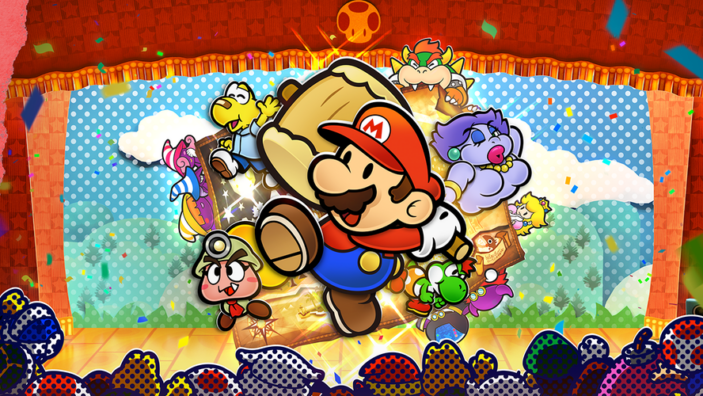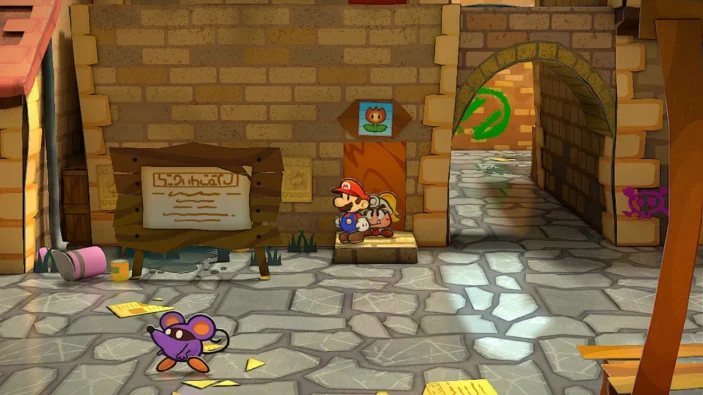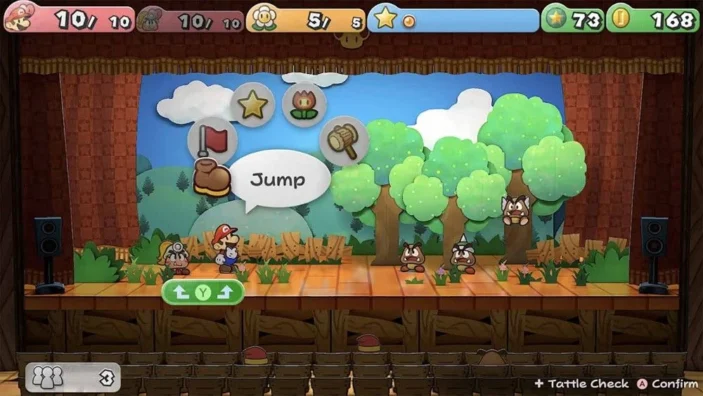
It’s hard to believe that the original Paper Mario: The Thousand-Year Door is 20 years old. Yes, you read that right. It’s also just as hard for me to believe that I remember checking out the original Gamecube version like it was yesterday.
This remake will feel incredibly familiar to anyone who has played the 2004 original, but adds to the experience in subtle, yet important ways. It’s visually stunning and blends satisfying RPG-like combat with environmental puzzle-solving and exploration with ease. Fans will be pleased, but I urge anyone who has not played this to do so, as it’s one of the most underrated Mario games out there today.
The Map Will Lead the Way
Princess Peach is in trouble! I mean, what else is new? While searching for a hidden treasure on the island of Rogueport, Princess Peach is soon kidnapped. Thankfully, Mario has conveniently received one of Peach’s most recent letters, alerting Mario to her last seen location.

Off to the island of Rogueport, Mario must befriend the locals as he uses his new-found map to seek out the seven Crystal Stars and open the door to a vast, long-hidden treasure. There are a few beats beyond this that I would rather not spoil, but all your favourite characters, along with some newer entries like the witty Goombella, are along for the ride.
The story is punchy, humorous and well-paced, even if it takes an hour or so for the ball to get rolling. I don’t have a problem with exposition, but when it’s presented through waves of text like this, with no voice acting, it can feel like a bit of a drag as you spam buttons to rush through it. Kids will love this from a gameplay perspective, and the story is admittedly a little more cinematic than your average Mario game. But I just feel like these long-winded conversations are packed with a little too much exposition, which will most likely break the attention span of some younger players.

The game’s eight chapters and prologue feel generally focused, with the occasional side-quest allowing Mario to explore the outer reaches of Rogueport. Thankfully, it never feels overwhelming, as Goombella can point you in the right direction or provide a handy hint at any time with the click of a button. Even when other party members are equipped and she is not by your side, this feature is always available.
Anything But Paper-Thin
General gameplay blends exploration from an isometric perspective with traditional turn-based RPG combat. You’ll explore the island of Rogueport across seven distinct areas as you search for each of the seven Crystal Stars.
Like any Mario game, you’ll find some more traditional platforming segments, but Paper Mario: The Thousand-Year Door excels with smart exploration-based puzzle solving, mainly thanks to a wide range of abilities that Mario unlocks throughout his journey. He’ll be able to fold into a paper plane to cover longer distances, turn sideways to slip through cracks and even utilise the abilities of a range of party members to help progress through each level.

Combat feels a little more traditional as you encounter enemies out in the open, before taking players to a stage for combat. You can even hit enemies with your hammer out in the open world to squeeze an extra attack in as the encounter begins. The stage setting literally plays into the combat mechanics, as special and unique abilities draw larger crowds which can help with gaining more stars to help level up Mario’s HP, stamina or badge slots. The crowd can even launch projectiles at you during combat, so you’ll have to pay attention.
Mario can head into combat with another party member, who can also be swapped out between turns. Both Mario and the additional party member are given a single attack or action, to help you gain the upper hand. Mario has access to his traditional jump, while his trusty hammer now helps with melee combat. Each move generally requires a well-timed button press to land with the most damage. I personally love how each enemy also throws a curveball into the mix, forcing you to switch up your attacks.
For example, some Goombas wear helmets with spikes meaning they can’t be jumped on, while some Goombas float in the air meaning they can’t be reached with a hammer. After each fight, you’ll also earn points to power up a specific star meter, which helps you activate a special attack/move during combat. That being said, it takes a while to build up and should be used sparingly, which adds to the overall challenge.

You’ll also be able to equip and utilise a number of consumable and handy items to help Mario and their friends in combat, some of which can be used on certain enemies with enhanced and sometimes devastating effects. Early on in the game, you’ll come across these rock-like creatures, which are impervious to your attacks and can only be damaged with the POW Blocks, which will need to either be found out in the open world or purchased from the store in town.
Players can also take advantage of Badges, perk-like upgrades which primarily help Mario in combat. Badges will take up a certain number of Badge Points, which Mario can increase as you progress to equip more useful and powerful badges. There are over 80 to unlock and experiment with, all of which have been brought over from the original.
Paper Mario: The Thousand-Year Door provides more than enough depth through thoughtful combat and variety through puzzle-based exploration, that no moment ever feels dull or repetitive. Environments feel open and dense, yet focused and fruitful, providing something worth exploring or finding around every corner.
Look the Part
Aside from a few refreshed menus that are easier to navigate, Paper Mario: The Thousand-Year Door bears many visual similarities to the original, but manages to squeeze in a level of polish that you rarely see in a Nintendo Switch game these days. The console is certainly showing its age, but it’s lovely to see this remake brimming with background details in both indoor and outdoor environments, along with some impressive textures and reflections in things like puddles. It’s all incredibly charming, and I love how the 2D and 3D visuals constantly work in tandem, as Mario’s paper-thin character models turn and navigate the open-world environments.
Performance leaves a little more to be desired, but only when things get a little too chaotic. There are certain points in the game where Mario and the gang are overwhelmed by a number of enemies on screen. The frame rate unfortunately dips quite severely, but it thankfully never lasts long enough to ruin the experience.

The soundtrack is also decent, but I feel as though the music played in combat, gets a little repetitive. Thankfully, the original Gamecube version’s tracks can also be unlocked with a specific badge, which helps with variety.
While the game doesn’t include any voice acting, the repetitive chirping of characters during conversations wears thin a little too soon, mainly due to the fact that the conversations themselves feel overly long.
Final Thoughts
Overall, Paper Mario: The Thousand-Year Door improves on an already fantastic game in almost every way. While the core experience feels almost identical, the improved visuals, and updated menus only serve to highlight the thoughtful, challenging combat and puzzle-based exploration.
Fans will surely gravitate towards this for its triumphant return to a new console, but newer audiences should pick this one up to experience one of the most underrated Mario titles to date.
FOUR AND A HALF STARS (OUT OF FIVE)
Highlights: Superb visuals; Engaging combat; Exploration-based puzzles are great
Lowlights: Stroy drags at times; Long portions of text-based exposition
Developer: Intelligent Systems
Publisher: Nintendo
Platforms: Nintendo Switch
Available: 23rd of May
Review conducted on Nintendo Switch (OLED model) with a code provided by the publisher.
